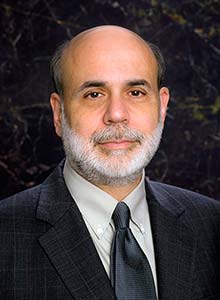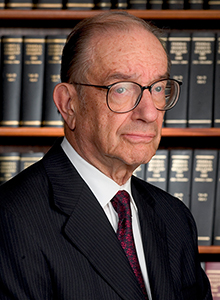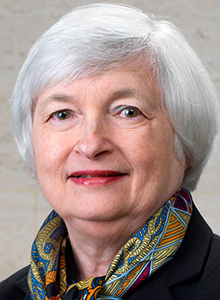
Ben S. Bernanke
- Chairman, Board of Governors, 2006–2014
- Governor, Board of Governors, 2002–2005
Ben Bernanke began a second term as chairman of the Board of Governors of the Federal Reserve System in February 2010. He originally took office as chairman in February 2006, when he also began a fourteen-year term as a member of the Board of Governors. His second term as chairman ended in January 2014 when he was succeeded by Janet Yellen.
Bernanke was born in Augusta, Georgia, and grew up in Dillon, South Carolina. He received a bachelor’s degree in economics in 1975 from Harvard University (summa cum laude) and a doctorate in economics in 1979 from the Massachusetts Institute of Technology.
Bernanke was an assistant professor of economics at the Graduate School of Business at Stanford University from 1979 to 1983 and associate professor of economics there from 1983 to 1985. His teaching career also included serving as a visiting professor of economics at New York University (1993) and at Massachusetts Institute of Technology (1989–90).
Beginning in 1985, Bernanke was a professor of economics and public affairs at Princeton University. From 1994 to 1996, Bernanke was the Class of 1926 Professor of Economics and Public Affairs at the university and was then the Howard Harrison and Gabrielle Snyder Beck Professor of Economics and Public Affairs and chair of the Economics Department at the university from 1996 to 2002 before becoming a member of the Board of Governors.
Over the years, Bernanke has served the Federal Reserve System in several roles. He was a member of the Board of Governors from 2002 to 2005; a visiting scholar at the Federal Reserve Banks of Philadelphia (1987–89), Boston (1989–90), and New York (1990–91, 1994–96); and a member of the Academic Advisory Panel at the New York Fed (1990–2002).
Before his appointment as chairman of the Board of Governors, Bernanke was chairman of the President’s Council of Economic Advisers, from June 2005 to January 2006.
As chairman of the Board, Bernanke led the Federal Reserve’s response to the financial crisis of 2006–10 and Great Recession. During his tenure the Federal Reserve took unprecedented steps to implement quantitative easing, a process whereby the central bank purchased billions of dollars of mortgage-backed securities and long-term treasuries to stimulate economic growth. Bernanke has also been credited with enhancing the Federal Reserve’s transparency and communications by holding quarterly press conferences to explain the decisions of the Federal Open Market Committee, providing forward guidance on short-term interest rates, and adopting a formal inflation target of 2 percent.
Throughout his career, Bernanke has published many articles on a wide variety of economic issues, including monetary policy and macroeconomics, and he is the author of several scholarly books and two textbooks. He has held a Guggenheim Fellowship and a Sloan Fellowship, and he is a fellow of the Econometric Society and of the American Academy of Arts and Sciences. Bernanke served as the director of the Monetary Economics Program of the National Bureau of Economic Research (NBER) and as a member of the NBER’s Business Cycle Dating Committee. In July 2001, he was appointed editor of the American Economic Review.
Bernanke’s work with civic and professional groups includes having served two terms as a member of the Montgomery Township (New Jersey) Board of Education.
Bernanke is married and has two children.
Written by the Board of Governors of the Federal Reserve System. See disclaimer.



